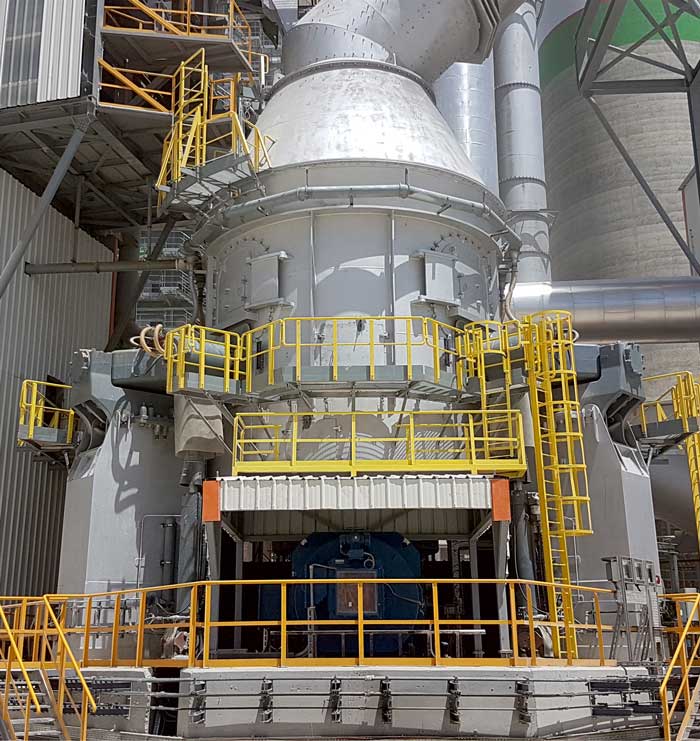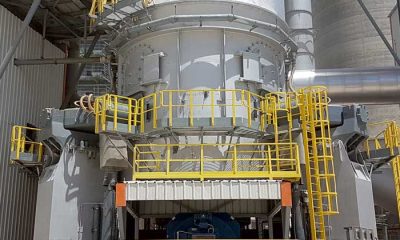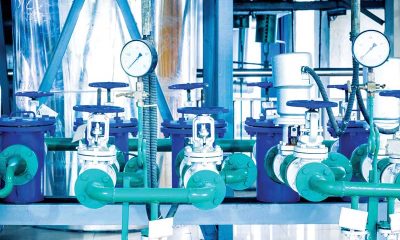Concrete
Safe plant concept means safety of the entire workforce
Published
3 months agoon
By
admin
Ashutosh Shrivastava, Head – Corporate Safety, JK Cement, talks about their commitment to maintaining a safe, healthy and environmentally friendly workplace as well as the continuous efforts being employed to enhance safety through technology, training and a proactive approach to addressing the behavioural aspects of safety.
What is the definition of a ‹safe› plant in your organisation?
Safe plant concept means safety of the entire workforce, including both employees and visitors coming to the plant for their respective nature of activity, by taking appropriate safety control measures as per the risk associated with the activity.
Tell us about the key areas where safety in a cement plant is of paramount importance?
In a cement plant, the key areas where safety management system plays an important role are:
- Plant gate for heavy vehicle entry: An SOP has been developed for the entry of heavy vehicles inside the plant for loading and unloading activity, along with an SOP of high standard vehicle traffic management safety, which is being followed.
- Packing plant area: In the cement industry, the maximum workforce involved is at the packing plant operation, as the major activity of cementing bags and loading them onto vehicles by using conveyor belts at loading points is being undertaken. For safe loading operations, an SOP has been developed. The SOP Task Risk Assessment is conducted and applied along with safety control measures, based on activity SOP.
- Process area: To maintain safe process operations, various associated activities are carried out. For example:
- Hot material handling: Poking and cyclone jam cleaning activities at preheater and kiln locations, etc.
Hot work: Naked flame producing activity (welding / grinding / gas cutting)
Working at height activity: Work at 1.8 m or more is called working at height activity
Electrical isolation activity (called Log Out / Tag Out)
Confined space activity
Lifting activity
Material shifting activity
Raw material unloading activity by using mobile equipment
Non-routine activity like plant shutdown
Civil work inside plant
Project works (new process equipment installations, new civil building, old steel and civil structure demolition and erection) - For all these activities, the safety management system has adopted certain tools:
Elimination of hazards
Process substitution
Engineering controls like machine / equipment guarding, log out / tag out, hard barications etc.
Administrative controls like permit to work system for high risk activities, Activity SOPs/OCP, activity risk assessment, job specific safety training, tool box talks, workplace safety inspection, safety observation tours, hazards reporting, near-miss and incident reportings, safety meetings, etc. - What are the safety equipment used by the personnel in different areas of work?
- Since there are different types of activities going on inside a cement plant, based on a specific activity, the workforce uses personal protective equipment (PPE) and other safe design equipment, such as:
- Hot works (welding / grinding / gas cutting): Heat resistance suit, hot work safety hand gloves, face shields, hot works safety goggles, safety helmet, safety shoes, gas cylinders pressure gauge, flash back arrestors, fire hydrant line, fire extinguishers, etc.
- Height works: Full body safety harness with double lanyard with shock absorber, life line, safe design scaffolding platform, boom lift, scissor lift, cherry picker, safety goggles, safety helmet, safety shoes, job specific safety hand gloves, etc.
- Hot material handling activity: Full body heat resistance suit, hot material handling safety gloves, heat resistance safety shoes, heat resistance face shield, fire hydrant line, fire extinguishers, etc.
- Confined space works: Use of gas detectors, forced ventilation system, life line. rescue equipment, electrical isolation system (log out / tag out), safety goggles, safety helmet, safety shoes, job specific safety hand gloves and nose mask.
- Electrical works: Electrical isolation system (log out / tag out), safety goggles, electrical job specific safety helmet, electrical job specific safety shoes, electrical job specific safety hand gloves, electrical job specific face hood, electrical shock resistance suit, etc.
- Lifting activity: Third party approved lifting tools and tackles and third party approved mobile equipment (mobile cranes).
- Material shifting activity by using mobile cranes: Third party approved lifting tools and tackles, third party approved mobile equipment (mobile cranes, fork lift, etc).
Tell us about your organisation’s policies about safety for people working in the plants?
Summary of the company’s Safety, Health and Environment Policy:
- The Company, as a good corporate citizen, assumes its business and ethical responsibility to create a safer and healthy workplace for its employees and a clean environment to its employees as well as surroundings.
- With the company›s global vision, we aspire for the highest international standards in plant design, equipment section, maintenance and operation, which are consistent with its emerging leadership position in cement business, the company will constantly encourage higher international standards in all areas including safety, health and environment.
- The Company as a part of its corporate philosophy and policy is committed to manufacture products safely and in an environment-friendly manner with due consideration for occupational health for employees and others who may be involved and / or affected by its operation.
- The company will comply with all applicable laws and regulations (local /state/federal) pertaining to its operations.
- The Company widely participates with the government, the industry and others concerned in creating relevant laws, regulations and standards to safeguard the community, workplace and environment.
- The Company is committed to the safety and health of the surrounding community at each manufacturing site and will make sure that any adverse environmental impact is minimised.
- The Company will provide adequate resources for the implementation and monitoring of safety policy.
- Each site and department will have this policy prominently displayed so as to bring it to the attention of all employees.
Does technology play a role in ensuring plant safety? If yes, how?
The technology used for safety purposes at JK Cement comprises:
- Digital safety management system module, which includes permit to work system, workplace hazard reporting and investigation, workplace near-miss reporting and investigation, workplace safety observation tour, safety statistics analysis, etc.
- Fire / smoke detectors installations at fire risk areas (reference AFR operation, bag go down, etc.) and connected with the emergency control room.
- Digital Control System (DCS) to control and monitor plant operations.
- Nitrogen Purging System installation at process equipment (reference coal fine bins, liquid AFR installation, etc.)
- Temperature sensors installation in different equipment.
- Gas Detection Monitoring by using multi gas detectors for confined space activity.
- CCTV cameras installed at multiple locations.
- GPS installation in company vehicles, etc.
- Tell us about the major challenges faced in ensuring plant safety?
- In the cement industry, the major challenge that we are facing is the behaviour of the workforce towards safety. To deal this challenge, we have developed safety management system tools that include:
- Safety Awareness Tool (safety induction, activity tool box talks, job specific safety training, monthly safety campaign and circulation incident-based safety alert).
- Safety Inspection Tool (behaviour-based safety observation tour, workplace safety round, focus internal safety audit and external safety audit).
- Reporting Tool (near miss reporting, hazard reporting and incident reporting).
- Emergency Preparedness Tool (mock drills, onsite emergency plan, fire fighting equipment facility and medical emergency facility).
- Risk Assessment Tool (job safety analysis, hazard identification and risk assessment).
- Safety Observation Discussion Platform Tool (monthly safety review meeting, management representative and workers representative safety committee meeting and daily all plants manufacturing meeting).
- Safety Guidelines Tool (Activity SOP / OCP, safety hand book, contractor obligation and OHS guidelines and activity dos and don’ts).
- Workplace Safety Display Tool (activity safety display and activity SOP display).
- Administrative Control Tool (risky activity permit to work system).
- Incident Investigation Tool (root cause analysis, CAPA and safety recommendation).
Do you conduct safety training and audits for your plant personnel? Explain in detail.
Workplace Safety Trainings and Safety Audits are an important tool of safety management system:
Safety Awareness Tools:
- Safety Induction
- Activity Tool Box Talks
- Job Specific Safety Training
- Monthly Safety Campaign
- Circulation Incident Based Safety Alert
- Safety Inspection Tools:
- Behaviour Based Safety Observation Tour
- Workplace Safety Round
- Focus Internal Safety Audit
- External Safety Audit
How do you plan to better the safety of your plant in the years to come?
We have prepared a focus safety element plan for the coming years to reach the next level of safety system at JK Cement.
Focus safety elements are:
- Human Safety
- Equipment Safety
- Fire Safety
- Electrical Safety
- Steel and Civil Structure Safety
- Workforce Behaviour Development Programmes towards Safety
- Stress Free Safety Culture
- Environment Friendly Workplace
- Healthy Workforce
- Use of job-specific advanced personal protective equipment
- Development of Injury-free Workplace based on Zero Harm Concept
- –Kanika Mathur
Concrete
JK Cement Boosts Production Capacity with New Production Line at Panna Plant
Published
2 days agoon
April 29, 2024By
admin
JK Cement hasannounced the inauguration of a new production line at its Panna Plant. This development marks a significant milestone in the company’s expansion strategy and reaffirms its commitment to meeting the growing demand for cement while setting its position as a key industry player.
The new production line at the Panna Plant effectively doubles its clinker production capacity to 6.6 million metric tons per annum (MTPA), up from the previous 3.3 MTPA. This expansion positions JK Cement to cater efficiently to the increasing demand for cement across Uttar Pradesh, Bihar, and Central India.
Dr Raghavpat Singhania, Managing Director, JK Cement Ltd., said, “JK Cement is built on a foundation of growth and expansion. Our new Panna Plant production line is a key pillar in our comprehensive business expansion plan, propelling us towards our vision of becoming a leading player in the cement industry. This strategic expansion allows us to meet the rising demand for high-quality cement, ultimately enhancing our ability to serve our customers. We remain committed to delivering value to all stakeholders and contributing to the nation’s development.”
Madhavkrishna Singhania, Deputy Managing Director and CEO, JK Cement Ltd., commented, “The launch of our new production line underscores JK Cement’s unwavering commitment to achieving long-term growth and operational excellence. This expansion empowers us to optimize production processes, unlock our full potential, and position ourselves for the future of the cement industry.”
The new production line integrates advanced automation systems for precise control and monitoring, minimising human intervention and enhancing efficiency. State-of-the-art machinery and equipment ensure optimal performance, reliability, consistent output quality, and energy efficiency, reflecting JK Cement’s commitment to sustainability. The plant incorporates energy-saving technologies, optimised kiln systems, and waste heat recovery systems to reduce energy consumption and lower the carbon footprint. Stringent quality control measures in the plant guarantee that cement products meet the highest industry standards.
Additionally, the Panna Plant expansion project generates employment opportunities, contributing to socio-economic growth in the region. JK Cement actively engages with the local community through educational, healthcare, and social initiatives, strengthening its bond with stakeholders.
With a significant investment of Rs. 2850 Cr, the Panna Plant expansion project reflects JK Cement’s vision for sustainable growth, environmental protection, and contribution to economic and social development in the region.
Concrete
Making durable concrete by using ternary blend
Published
3 days agoon
April 27, 2024By
admin
Cement, flyash, ground granulated blast furnace slag(GGBFS) are the key components in the ternary blend used to make concrete. Nagesh Veeturi and Sumanta Sahu of KEC International – Civil Business, shed light on reducing the carbon footprint of cement production by using supplementary cementitious materials.
Cement is prime ingredient in concrete. One tonne of cement produces around 0.8 to 1 MT of carbon dioxide. It’s worth noting that efforts are being made to reduce the carbon footprint of cement production by using supplementary cementitious materials such as flyash and GGBS in concrete. In case of ternary blended concrete, supplementary cementitious materials flyash and GGBS are used in addition to cement, sand, aggregate, water and admixture.
To evaluate the percentage of replacement of cement with flyash and GGBS, one needs to understand the properties of concrete mix with flyash and GGBS as ingredients, structure strength, stripping time and durability requirements.
Properties of Supplementary Cementitious Materials
Flyash
Pulverised coal is used in thermal power plants for electricity generation. A by-product of this combustion reaction is fly ash. The electrostatic precipitators (ESPs) used inside chimneys of the power plants remove flyash before ejecting out the combustion gases into the atmosphere. Fly ash is a very fine particle like residue, which has pozzolanic properties. Hence it is often blended with cement and also used as partial replacement of cement.
Fly ash consists of silica (SiO2), alumina (Al2O3) and calcium oxide (CaO) as its major components. Fly ash can be of two types – C type and F type. C type fly ash is rich in calcium oxide and possesses both cementitious and pozzolanic properties whereas F type fly ash is low in calcium oxide content and possesses only pozzolanic properties.
- Due to spherical shape of flyash, water demands in concrete is reduced, concrete becomes more cohesive.
- Silica in flyash reacts with calcium hydroxide released from cement to form CSH Gel, Formation of CSH Gel leads to increase in strength of concrete further and make the concrete dense and durable.
- 35 per cent of cement can be replaced with flyash according to IS specification. However, for mass concrete high volume flyash up to 50 per cent can be used.
- Early strength observed to be less for flyash concrete.
- Due to slow development of strength of concrete, stripping time gets delayed.

(Flyash produced from Thermal Power Plant)
Ground Granulated Blast Furnace Slag (GGBFS)
Blast furnace slag is a by-product of iron ore during iron extraction process. Amongst all mineral admixtures, blast furnace slag has the highest specific gravity (2.8 to 3.0). Typically, the slag fineness is slightly more than that of the cement.
There are various types of slag available like air cooled slag, expanded or foamed slag, granulated slag. Among these only the granulated slag is commonly used as a mineral admixture. It is a highly reactive form of slag and is usually quenched to form a hardened matter which is then grounded into particles of fineness almost same as that of cement. Hence the material is called as ‘ground granulated blast furnace slag’.
GGBFS possesses both cementitious and pozzolanic properties. An activator is needed to hydrate the slag.
- GGBFS increases the initial setting time of the concrete. But it does not alter the workability of the concrete much because its fineness is almost same as that of the cement.
- The early rate of strength gain in concrete is diminished by replacement of cement in the concrete with GGBFS.
- The final strength is improved by slag cement and also the durability of the concrete is increased.
- Concrete uses in marine construction are highly prone to chemical attack and corrosion. GGBFS as a concrete ingredient increases resistance against sulphate and chloride attack.
Normally concrete tends to segregate with GGBS as ingredient,


(GGBFS produced from Steel Plant)\
Concrete with flyash and GGBS as ingredients (Ternary Blend)
Ternary blended concrete is observed to be more cohesive and workable due to presence of flyash in concrete. Early strength gain can be achieved by using both Cement and GGBS in concrete. Concrete with ternary blend is win-win situation in terms of good product quality, optimising the cost of concrete, durability and resistance against chemical attack. Additionally, the use of SCMs in concrete can contribute to sustainability efforts by minimizing the cement content which is associated with significant carbon dioxide emission during its manufacturing process.
The hydration process of ternary blended concrete is divided into primary reaction by OPC and GGBS, pozzolanic reaction of GGBS and flyash as the secondary process. Both materials react with Calcium hydroxide produced by cement hydration to form CSH gel, which gives denser microstructure than conventional OPC concrete. The dense structure improves the durability properties of ternary blended concrete. Process yields to minimise penetration of aggressive chemicals such as sulphate, chloride as compared to conventional concrete mix.
Conclusion
Use of supplementary cementitious materials always improve the durability properties of concrete along with cost optimisation. Selection of supplementary cementitious materials, percentage replacement with cement is taken considering the strength and durability requirements of structure.

Ultratech Cement will once again use the state-of-the-art vertical roller mill technology from Gebr. Pfeiffer, to build three new clinker production lines.
As Ultratech Cement gears up for its three new clinker production lines, a corresponding follow-up order was awarded to Gebr. Pfeiffer SE, Germany, and its Indian subsidiary Gebr. Pfeiffer (India).
As the largest cement plant operator in India and one of the top ten in the world, Ultratech Cement from Mumbai, India, is contributing to shaping the future of the cement industry. At their Happy 3 plant, the cement raw material will be ground in an MVR 5000 R-4 mill. With a 5,300-kW drive, this mill can grind approx. 705 tph to a product fineness of 1.5 per cent R 212 µm. The integrated SLS 5300 VR high-efficiency classifier, with optimised flow and electrical efficiency, separates the product to achieve the target fineness.
For the grinding of approx. 45 t/h of pet coke or approx. 90 t/h of coal, three vertical roller mills of the type MPS 3550 BK will be supplied. These are equipped with a 1,300-kW gearbox, as standard. By using Pfeiffer MPS mills, Ultratech is able to process both pet coke and coal, as well as any mixture of these two materials, at the same speed of the grinding bowl, thus avoiding three expensive frequency converters. The new coal mills will be equipped with an integrated high-efficiency classifier type SLS 3750 BK of the latest design.
It is important for UltraTech’s stock of spare parts that the latest MVR mills are characterised by grinding rollers based on the R=C principle, as this brings significant advantages for the customer. It means that these mills are equipped with grinding rollers that, equipped with the corresponding grinding elements, can be used, along with the appropriate power modules, for raw meal grinding as well as for cement grinding.
As the components of rollers, grinding roller suspension system, roller arms in cement and raw mills are identical with the ones which the customer has already received from Gebr. Pfeiffer, he requires a smaller number of spare parts in stock. This is because the components mentioned can be used for all his cement and raw mills.
The MVR 5000 R-4 mill for the Happy 3 plant has four actively redundant grinding rollers and can also be operated with two grinding rollers in the event of planned or unplanned maintenance work. This mill can then still produce approximately 70 per cent of the nominal capacity, so that the cement rotary kiln can continue to be fed with raw material.
The MVR mills are equipped by Gebr. Pfeiffer with the modern systems for preventive, maintenance-oriented condition monitoring. This will enable the customer to implement modern, digital maintenance concepts. The MPS mills will be prepared to include such options at a later point in time.
Order execution will be jointly by the subsidiary Gebr. Pfeiffer (India) and Gebr. Pfeiffer SE (Germany). The entire customer support and plant engineering will be carried out by competent Pfeiffer engineers in Noida.
The core components, such as gearbox, grinding bowl, grinding roller suspension system and the grinding rollers, are supplied from Europe by Gebr. Pfeiffer SE. The remaining components, such as the foundation parts, the housings, the classifiers and most of the plant components will be provided by Gebr. Pfeiffer (India).
The Customer Support Centre in Noida, being close to the customer, will later also provide support for the plants. This can be done in real terms by sending personnel to the plants or via remote data access.
For this purpose, Gebr. Pfeiffer offers hardware and software solutions, which are supported by competent technical personnel during normal office hours, if possible, in the local language. The picture shows an MVR mill of similar size (Type MVR 5000 R-4).

JK Cement Boosts Production Capacity with New Production Line at Panna Plant

Making durable concrete by using ternary blend

Ultratech sources VRM from Gebr. Pfeiffer

RAHSTA to showcase cutting-edge road construction tech, says NCC Director

RAHSTA will drive road construction innovation: Sundaresan

Environment Ministry revises rules of solid waste management

M-sand boards new terrain

Process and quality optimization in cement plant.
Concrete: A Highly Sustainable Building Material





















